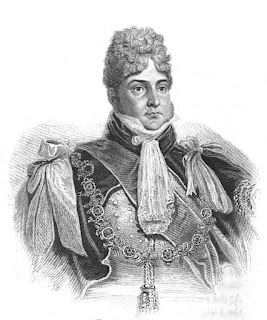 |
| Carlton Palace From Memoirs of George IV by Robert Huish (1831) |
Public days
On 19 June 1811, the Prince Regent held a lavish fête at Carlton House. His critics may have balked at the cost, but it was generally deemed to have been a great success and seen as an entertainment “worthy of a Prince”.
You can read about the Prince's fête here.
After the fête, the Regent graciously opened his palace to the public so that they could share in the magnificence of his home and the superb decorations specially built for the fête. The Gentleman’s Magazine reported that
...many thousands were delighted by the sight, which however, we are sorry to say, did not close without some serious accidents.1
The Edinburgh Annual Register reported that on 24 June, 20-30,000 respectable visitors were admitted by ticket to Carlton House. Some ladies fainted and
...at the entrance, several ladies lost their scarves and mantles; cloaks, tippets, and other garments were torn off; some lost their shoes, and a variety of other ornaments were torn off and trod upon.2
The crowds were so great that Colonel Bloomfield ordered a party of life guards to attend in Pall Mall to regulate the carriages. The throng was so great that a system of timed entrance was instigated, letting a few hundred visitors in at a time and then closing the gates.
Unfortunately this caused great pressure on the steps and several elegantly dressed ladies were in danger of being crushed. According to The Edinburgh Annual Register:
Lord Yarmouth very gallantly stood forward to their relief, and lifted them in at the windows of the great hall.3
The following day, on 25 June, the crowds were even larger as this was the last day that the palace was to be open to the public. Horse guards paraded in front of the house and along Pall Mall. The gates were only opened periodically in an attempt to regulate the flow of visitors, but when this happened “the torrent was so rapid, that many people were taken off their feet, some with their backs towards the entrance, screaming to get out.”4
To avoid further incident, Lord Yarmouth and the Duke of Gloucester announced that no more visitors would be admitted.
 |
| The Duke of Gloucester from A Biographical Memoir of Frederick, Duke of York and Albany by John Watkins (1827) |
The multitude, however, refused to disperse and the gates were necessarily opened again later to ease the congestion inside Carlton House. The masses pushed forwards relentlessly and
...when at last the crowd got inside the Carlton House gates, four females were found in a lifeless state, lying on their backs on the ground, with their clothes almost completely torn off.5
One lady was trodden on so badly that she was not expected to live, an elderly lady had her leg broken and two others were seriously hurt.
They were to be seen all round the gardens, most of them without shoes or gowns; and many almost completely undressed, and their hair hanging about their shoulders.6
The Regent was very upset by the way that the public days had been managed, though blame could not be attributed anywhere. A notice was put up on the walls of Carlton House announcing that it would not again be open to visitors, by order of the Prince Regent.
Rachel Knowles writes clean/Christian Regency era romance and historical non-fiction. She has been sharing her research on this blog since 2011. Rachel lives in the beautiful Georgian seaside town of Weymouth, Dorset, on the south coast of England, with her husband, Andrew.
Find out more about Rachel's books and sign up for her newsletter here.If you have enjoyed this blog and want to encourage me and help me to keep making my research freely available, please buy me a virtual cup of coffee by clicking the button below.
Notes
- The Gentleman's Magazine and Historical Chronicle (E Cave, 1811, London).
- The Edinburgh Annual Register (John Ballantyne & Co., 1813, Edinburgh).
- Ibid.
- Ibid.
- Ibid.
- Ibid.
Hibbert, Christopher, George IV (Longmans,1972, Allen Lane, 1973, London)
Huish, Robert, Memoirs of George IV (Thomas Kelly, 1830, 1831, London)
Stuart, Dorothy Margaret, Regency Roundabout (Macmillan & Co. Ltd, 1943, London)
The Edinburgh Annual Register (John Ballantyne & Co., 1813, Edinburgh)
The Gentleman's Magazine and Historical Chronicle (E Cave, 1811, London)



Gosh, that's frightening! You expect people of that era to perhaps be more elegant in conducting themselves, not to be trodden on and ripped bare! Must have been quite awful to see :(
ReplyDeleteMaybe the Regency wasn't such a civilised period after all!
DeleteSoccer matches. That is all.
DeleteVery interesting. Goes to show you that people haven't changed much throughout history.
ReplyDeleteAnd that royal occasions drew in the crowds even back in the Regency!
Delete